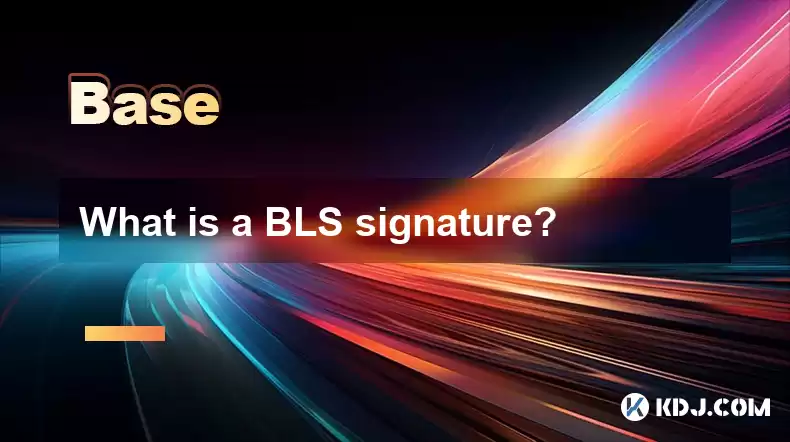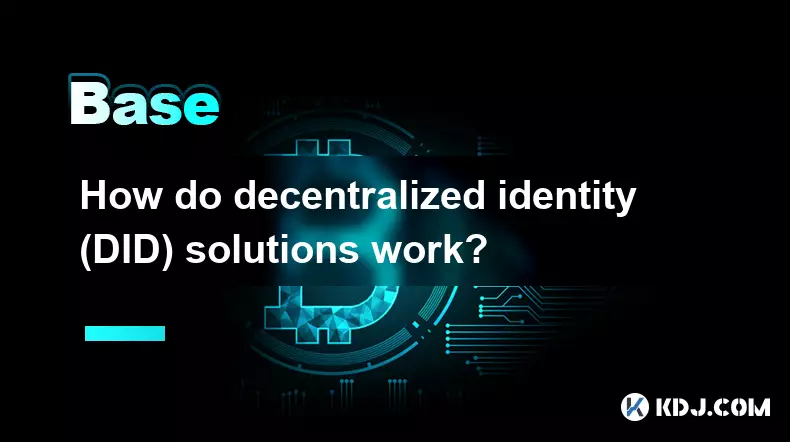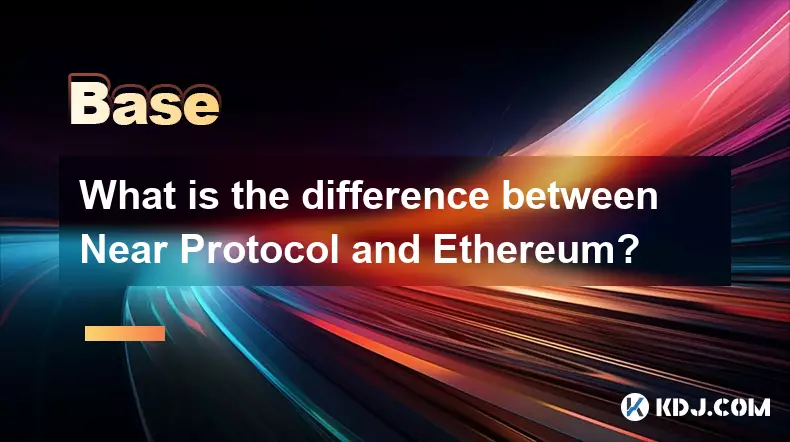-
 bitcoin
bitcoin $99177.955738 USD
-7.32% -
 ethereum
ethereum $3187.183061 USD
-12.38% -
 tether
tether $0.999809 USD
0.00% -
 xrp
xrp $2.117933 USD
-9.42% -
 bnb
bnb $906.710033 USD
-9.17% -
 solana
solana $149.367737 USD
-10.74% -
 usd-coin
usd-coin $0.999816 USD
0.01% -
 tron
tron $0.281498 USD
-0.38% -
 dogecoin
dogecoin $0.156292 USD
-8.00% -
 cardano
cardano $0.500744 USD
-10.19% -
 hyperliquid
hyperliquid $38.087358 USD
-4.58% -
 chainlink
chainlink $14.097831 USD
-8.54% -
 bitcoin-cash
bitcoin-cash $463.329916 USD
-9.22% -
 ethena-usde
ethena-usde $0.999078 USD
-0.01% -
 unus-sed-leo
unus-sed-leo $9.475862 USD
-0.79%
What is a BLS signature?
BLS signatures, used in Ethereum 2.0 and Zcash, offer short, aggregatable signatures that enhance blockchain efficiency and scalability.
Apr 08, 2025 at 03:50 pm

A BLS signature, named after its inventors Dan Boneh, Ben Lynn, and Hovav Shacham, is a type of digital signature scheme that utilizes bilinear pairings in elliptic curve cryptography. BLS signatures are known for their short signature size and the ability to aggregate multiple signatures into a single, compact signature. This makes them particularly useful in blockchain and cryptocurrency applications where efficiency and scalability are crucial.
How BLS Signatures WorkBLS signatures operate on the principle of bilinear pairings, which are mathematical operations that map two elements from one group to another. In the context of BLS signatures, these groups are typically elliptic curve groups. The process of generating and verifying a BLS signature involves several steps:
- Key Generation: A user generates a public-private key pair. The private key is a random number, and the public key is derived from the private key using a point multiplication on an elliptic curve.
- Signing: To sign a message, the user hashes the message and then multiplies the hash by their private key. This results in a point on the elliptic curve, which is the signature.
- Verification: To verify the signature, the verifier uses the public key and the message. They hash the message, multiply it by the public key, and then use a bilinear pairing to check if the result matches the signature.
BLS signatures offer several advantages that make them attractive for use in cryptocurrency and blockchain systems:
- Short Signatures: BLS signatures are significantly shorter than other types of signatures, such as ECDSA signatures. This reduces the amount of data that needs to be stored and transmitted.
- Aggregation: One of the most powerful features of BLS signatures is the ability to aggregate multiple signatures into a single signature. This can greatly reduce the size of data in blockchain transactions, improving scalability.
- Efficiency: The verification process for BLS signatures can be more efficient, especially when dealing with aggregated signatures.
BLS signatures have found several applications within the cryptocurrency space:
- Ethereum 2.0: Ethereum's transition to Ethereum 2.0 includes the use of BLS signatures for validator attestations. This helps in reducing the data size and improving the efficiency of the consensus mechanism.
- Zcash: Zcash uses BLS signatures for its shielded transactions, which provide enhanced privacy and security.
- Algorand: Algorand employs BLS signatures for its consensus protocol, allowing for fast and secure transaction validation.
Implementing BLS signatures involves several steps and considerations. Here is a detailed guide on how to implement BLS signatures in a cryptocurrency application:
Choose a Library: Start by selecting a cryptographic library that supports BLS signatures. Popular choices include
bls-signaturesfor Python andblstfor C.Generate Keys: Use the library to generate a private key and derive the corresponding public key. For example, in Python using
bls-signatures:from bls import PrivateKey, PublicKeyprivate_key = PrivateKey.from_seed(b'seed')public_key = private_key.get_public_key()
Sign a Message: Hash the message and sign it using the private key. Continuing with the Python example:
message = b'message'signature = private_key.sign(message)Verify the Signature: Use the public key to verify the signature. In Python:
is_valid = PublicKey.from_bytes(public_key.serialize()).verify(signature, message)Aggregate Signatures: If needed, aggregate multiple signatures into a single signature. This can be done as follows:
signatures = [sig1, sig2, sig3]aggregated_signature = PrivateKey.aggregate_signatures(signatures)Verify Aggregated Signatures: Verify the aggregated signature using the corresponding public keys:
public_keys = [pk1, pk2, pk3]is_valid = PublicKey.aggregate_verify(public_keys, messages, aggregated_signature)
While BLS signatures offer many benefits, they also come with specific security considerations:
- Pairing-Friendly Curves: BLS signatures require the use of pairing-friendly elliptic curves. These curves must be carefully chosen to ensure security.
- Randomness: The generation of private keys must use a secure random number generator to prevent attacks.
- Implementation Vulnerabilities: As with any cryptographic scheme, the implementation of BLS signatures must be carefully audited to prevent vulnerabilities.
The performance of BLS signatures can vary depending on the implementation and the specific use case. Here are some general performance metrics:
- Signature Size: A typical BLS signature is around 48 bytes, significantly smaller than ECDSA signatures which are usually 64 bytes.
- Verification Time: The verification time for a single BLS signature is comparable to ECDSA, but the verification of aggregated signatures can be much faster.
- Aggregation Time: The time to aggregate multiple signatures is generally linear with the number of signatures, but the resulting aggregated signature can be verified much more efficiently.
- Can BLS signatures be used with any blockchain?
BLS signatures can be used with any blockchain that supports the necessary cryptographic operations. However, the specific implementation and integration will depend on the blockchain's architecture and the cryptographic libraries it supports.
- Are BLS signatures more secure than other types of signatures?
BLS signatures are considered secure when implemented correctly. They offer different security properties compared to other signatures like ECDSA, particularly in terms of aggregation and short signature size. However, the security of any signature scheme depends on the implementation and the underlying cryptographic assumptions.
- How do BLS signatures improve scalability in blockchain networks?
BLS signatures improve scalability by allowing multiple signatures to be aggregated into a single signature. This reduces the amount of data that needs to be stored and transmitted on the blockchain, which can significantly improve the network's throughput and efficiency.
- What are the main challenges in implementing BLS signatures?
The main challenges in implementing BLS signatures include choosing the right pairing-friendly curves, ensuring secure random number generation, and thoroughly auditing the implementation to prevent vulnerabilities. Additionally, integrating BLS signatures into existing blockchain systems can require significant changes to the consensus and validation mechanisms.
Disclaimer:info@kdj.com
The information provided is not trading advice. kdj.com does not assume any responsibility for any investments made based on the information provided in this article. Cryptocurrencies are highly volatile and it is highly recommended that you invest with caution after thorough research!
If you believe that the content used on this website infringes your copyright, please contact us immediately (info@kdj.com) and we will delete it promptly.
- La Culex, Crypto Investment, and Pudgy Penguins: A NYC Perspective
- 2025-11-05 10:30:13
- Score Big with BetMGM: NBA, NFL, and the TOP150 Bonus Code
- 2025-11-05 08:50:13
- BullZilla, Crypto Presales, and Cronos Aster: What's the Buzz?
- 2025-11-05 09:10:01
- BullZilla Presale: The Roaring Crypto Opportunity You Can't Ignore
- 2025-11-05 08:55:01
- Ripple, USD Stablecoins, and the $1 Billion Milestone: A New Era for Cross-Border Payments?
- 2025-11-05 09:10:01
- New Coin Honors Unknown Soldier: A Nation Remembers
- 2025-11-05 08:35:01
Related knowledge

How do decentralized identity (DID) solutions work?
Oct 14,2025 at 11:36pm
Understanding Decentralized Identity in the Blockchain Ecosystem1. Decentralized identity (DID) solutions are built on blockchain networks, allowing i...

What is the "halving" event for cryptocurrencies other than Bitcoin?
Oct 25,2025 at 12:19pm
Decentralized Exchanges Gain Momentum in 20241. Decentralized exchanges (DEXs) have seen a surge in trading volume as users prioritize control over th...

What is the difference between Near Protocol and Ethereum?
Oct 15,2025 at 08:01am
Near Protocol and Ethereum: Core Architectural Differences1. Near Protocol operates on a sharded blockchain architecture known as Nightshade, which al...

What does it mean for code to be "open source" in crypto?
Oct 12,2025 at 01:54pm
Understanding Open Source in the Cryptocurrency Ecosystem1. In the context of cryptocurrency, open source refers to software whose code is publicly ac...

What is the purpose of a "testnet"?
Oct 12,2025 at 09:01am
Understanding the Role of Testnets in Blockchain Development1. A testnet serves as a parallel version of a blockchain network, designed specifically f...

How to avoid phishing scams in crypto?
Oct 13,2025 at 06:18pm
Understanding Common Crypto Phishing Tactics1. Cybercriminals frequently use fake websites that mirror legitimate crypto exchanges or wallet platforms...

How do decentralized identity (DID) solutions work?
Oct 14,2025 at 11:36pm
Understanding Decentralized Identity in the Blockchain Ecosystem1. Decentralized identity (DID) solutions are built on blockchain networks, allowing i...

What is the "halving" event for cryptocurrencies other than Bitcoin?
Oct 25,2025 at 12:19pm
Decentralized Exchanges Gain Momentum in 20241. Decentralized exchanges (DEXs) have seen a surge in trading volume as users prioritize control over th...

What is the difference between Near Protocol and Ethereum?
Oct 15,2025 at 08:01am
Near Protocol and Ethereum: Core Architectural Differences1. Near Protocol operates on a sharded blockchain architecture known as Nightshade, which al...

What does it mean for code to be "open source" in crypto?
Oct 12,2025 at 01:54pm
Understanding Open Source in the Cryptocurrency Ecosystem1. In the context of cryptocurrency, open source refers to software whose code is publicly ac...

What is the purpose of a "testnet"?
Oct 12,2025 at 09:01am
Understanding the Role of Testnets in Blockchain Development1. A testnet serves as a parallel version of a blockchain network, designed specifically f...

How to avoid phishing scams in crypto?
Oct 13,2025 at 06:18pm
Understanding Common Crypto Phishing Tactics1. Cybercriminals frequently use fake websites that mirror legitimate crypto exchanges or wallet platforms...
See all articles










































































